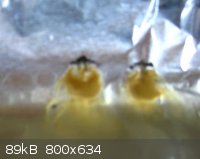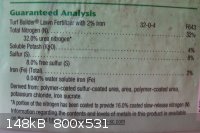White Yeti
National Hazard
   
Posts: 816
Registered: 20-7-2011
Location: Asperger's spectrum
Member Is Offline
Mood: delocalized
|
|
Reaction between urea and aluminium and oxygen.
I encountered a problem while re-crystallizing a concentrated urea solution and I was curious as to what might have been the cause of the problem.
Normally, I re-crystallize crystalline substances in glass jars. This doesn't work very well in winter because crystallization under these conditions
takes a very long time. So I tried to re-crystallize a concentrated urea solution from fertilizer in a shallow aluminium foil dish. The solution
significantly corroded the aluminium at specific points. Picture:

I know the picture is not very clear, but it essentially shows the reaction. The black area is a hole where the solution reacted right through the
foil.The orange/yellow gel seen below each hole bears some resemblance to aluminium hydroxide, which it may very well be.
Here is the label from the fertilizer canister:

What is puzzling though, is that these corrosion loci were not evenly distributed throughout the dish, all these corrosion sites were located at the
boundary between the foil, the solution, and the air, suggesting that oxygen has a role to play.
I am aware that chloride ions can catalyze the reaction of air and water with aluminium to yield aluminium hydroxide, but I have only seen this in a
high concentration of chloride ions. In fact, reacting aluminium with brine and air works very well for preparing aluminium hydroxide. Furthermore,
when aluminium reacts with brine in this manner, bubbles of hydrogen are formed; no bubbles of hydrogen were seen in this case.
This reaction took place over the course of 2-3 days and at a temperature of 58F, indoors, with minimal airflow and fairly dry air. The temperatures
were far too low for the decomposition of urea, although some decomposition may have taken place during dissolution with warm water (~80 degrees C).
The presence of ammonia was tested by adding a copper acetate solution to the urea solution and showed negative results, no visible formation of the
copper-ammonia ligand.
This isn't a big deal, but I'm curious to know what reaction might have taken place.
Any ideas?
"Ja, Kalzium, das ist alles!" -Otto Loewi
|
|
|
AJKOER
Radically Dubious
    
Posts: 3026
Registered: 7-5-2011
Member Is Offline
Mood: No Mood
|
|
My speculation, the solution contact points are entry points for moisture. It is known that Urea + H2O forms NH3. Ammonia, a base, lowers the pH and
permits the attack of the protective Al2O3 with the Aluminum readily reacting with water.
Now, other more complex organic compounds are possible, but this appears to me to be a simple explanation. To test, repeat the experiment in a large
dome of the same air but in the presence of CaCl2 which will remove moisture (and even ammonia).
|
|
|
woelen
Super Administrator
        
Posts: 7977
Registered: 20-8-2005
Location: Netherlands
Member Is Offline
Mood: interested
|
|
The combination of urea and oxygen (like the combination of ammonia and oxygen) can be a decent oxidizer, due to formation of complexes.
This principle is used in extraction of gold with cyanide (cyanide and oxygen together dissolve gold, due to complex formation). Thiourea might be
capable of forming complexes with Al(3+) and this could make oxidation of aluminium more easy. This also explains why the corrosion starts at the
boundary between air and solution.
|
|
|
blogfast25
International Hazard
    
Posts: 10562
Registered: 3-2-2008
Location: Neverland
Member Is Offline
Mood: No Mood
|
|
Whatever it is, using Al foil dishes as crystallisation dishes for watery solutions is a silly idea. Al is far too reactive. If you don't want to use
glass, try HDPE or PP dishes, both are quite inert and very available. You can even use PP on a steam bath, up to about 140 C.
|
|
|
|